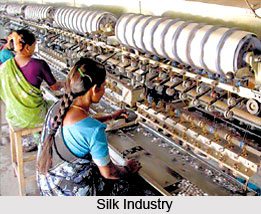 The economy of Purulia is solely dependent on the industrial sector. Purulia in the southwestern section of West Bengal is an enclosed tract bounded by Bardhaman, Bankura and Midnapore in West Bengal and the Bokaro and the Ranchi district of Jharkhand.The geographical proximity with the resourceful districts helps Purulia economically.
The economy of Purulia is solely dependent on the industrial sector. Purulia in the southwestern section of West Bengal is an enclosed tract bounded by Bardhaman, Bankura and Midnapore in West Bengal and the Bokaro and the Ranchi district of Jharkhand.The geographical proximity with the resourceful districts helps Purulia economically.
Two large-scale units play the major role in forming the economic groundwork of Purulia. The Santaldihi Thermal Power Plant in Santaldihi and the Damodar cement Factory at Madhukunda. Moreover one major unit i.e. Pumped Storage Project, with a capacity of generating 4X 225 MVV is under construction. The power stations supplies electricity throughout the district and in the adjoining parts. These plants also provide employment to the local inhabitants, thus supports the local economy.
Although no large-scale industry has been initiated in the last 1 year, the West Bengal incentive Scheme 2000 and the effort of the district administration for over 2 years has started paying dividends, which is significant to develop the financial status of Purulia. During the last year, in the manufacturing sector specially the sponge iron sector about 306.17 crores has been invested, which is comparable to the economically developed districts of West Bengal. The medium scale industries, which have already been set up or proposed to be set up in the following years will change the economic scenario of Purulia in respect to the financial status of West Bengal.
Large-scale industries, the backbone of Purulia`s economy are supplemented by a large number of small-scale industries. As per the official accounts about 2018 industries so far are registered as the permanent SSI (Small Scale Industry) units, serving the financial set up of Purulia.
In the arena of small-scale industry, the lac industry and sericulture are predominant. Lac is cultivated in all the blocks in Purulia and about 70,000 people draw their living from lac cultivation. Purulia, itself produces about 90% of total lac production in West Bengal. Hence a bulk of Purulia`s economy is supported by the export of lac. Lac processing units are also a major source of Purulia`s income. Several unregistered lac-processing units (small/ or family units) etc. have sprung to support the local economy. 23 large units are there, which takes part in the mainstream market economy of Purulia by exporting the products.
Sericulture or the silk Industry forms another arm of the economy of Purulia. The silk industry is supported by the ample amount of cocoons or the caterpillar larvae as raw materials. The mostly acclaimed among the sericulture is the Tasar culture, which is even the principal stay of the rural folk in Purulia. In the last century, the Raghunathpur Tasar was the principal material transacted in the neighboring areas.
The small-scale cottage industry however serves the rural economy in Purulia. The underdeveloped and the backward class mainly the Scheduled castes and the Scheduled tribes, who cannot participate in the urban economy, solely depend on the cottage industries.
According to the Industrial census of 2002 about 841 SSI units are found in the running conditions. Most of these SSI units are comprised of agro and allied industries. The agro-based industries mainly include the rice milling, wheat flour making and mustard oil manufacturing. The forest based industries include saw milling, leaf cup manufacture, lac processing etc. Chemical industries also share an important section in the economy of Purulia. It has been registered that the chemical industries provide employment to a large section of population, thereby serving the local economy. Gate and grill, small toys manufacturing, brass and bell metal etc are the small-scale industries, which has been developed by the welfare projects of the government. The government organization SEWA (Self-Employed Woman`s Association) has been operating recently to engage the women folk of the underdeveloped zones, thereby making them financially self-sufficient. Also these projects like SEWA indirectly supportive to provide a desirable standard to the local economical set up.
The subsidiary industries, which have now developed in the vicinity of Purulia, engage a large mass of local population. The manufacturing of plastic goods is a subsidiary industry of the Haldia Downstream Project. In the recent times of globalization, when the business classes are willing to invest in the industrial sectors, Purulia became a site of their choice. The government schemes and projects with the private investors have become instrumental to change and improve the economic scenario of Purulia.
Since the regional topography of Purulia offers an undulating landscape and red leterite kind of soil, Purulia does not make any significant progress. However the cultivation of the lac and raw silk constitute the principal agricultural products. Recently the standard of agriculture has been uplifted with the use of modern technology and the government fund. The project of AGMARKET has been proposed by the district administrator to regulate the market prices of the cultivated products. The agricultural sectors, unlike the industries only supplies the raw materials to the agro based factories and provide livelihood to the cultivators.




















